In Plain Light 04.17 – The Retro Issue
Welcome to this month's newsletter!
In this issue:
You may want to rotate your phone in order to improve your browsing experience on this site.

If you were young
When you are young, you can't wait to get older.
You make plans and look into the future. You want to start doing things you couldn't do before, and you want to do these things without asking anyone's permission first.
Sooner or later, we all succeed at it. You succeed at it. And then, somewhere down the road, a strange thing happens.
You start looking back.
Because now you know.
You know how it was in the past, and you know what to expect from the future. You think the former is so much better, that it is much more worth.
You still might be wrong.
You know how it was, check. Are you sure you know how it will be?
If you are, make it unsure again. Do something different, something crazy, something new. Surprise yourself. Just don't ask anyone's permission.
Back to the past
The title sequence in Contact, a 1997 science-fiction Hollywood blockbuster, follows an imaginary spaceship as it moves away from the Earth. A spectacular flight animation is accompanied by the combined sound of old radio signals still hovering in the void of the universe. With distance, the noise gets fainter and then, eventually, gives way to silence yet to be penetrated by our radio waves.
If you'd rather stop and listen, no need to hunt the lost sound in a spacecraft. Stay in the comfort of your home and ...
Turn on the radiooooo
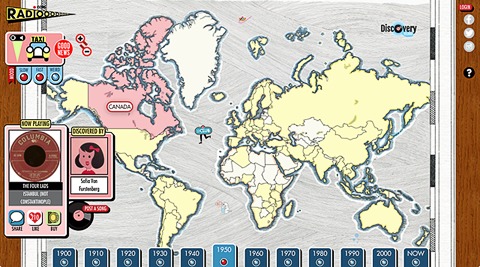 The world in the 50s: (still) much to discover
The world in the 50s: (still) much to discoverThe site is, at first glance, not much more than one page and occasional help splashes. Using it is no rocket science. Choose a decade, then click on a map to select a country, enjoy.
The music originates from old vinyl records, and dates begin with 1900, long before the radio era. Still, the site operates like a radio set. You can't fast forward a song, or search for any. At most, you can choose between "slow", "fast", and "weird" moods.
In taxi mode, you can combine several decades and/or countries to your own mix, but in general, if you don't like what they play at the moment, just switch the channel by choosing another time or place!
In addition to real countries which at least existed once, there are several "mysterious" islands spread across the map. They offer new and themed titles, and are well worth exploring. The news section contains several feature interviews and other written content, which you can enjoy while listening.
As a registered user, you are able to upload your favourite music, "like" other records, and edit the information on albums and songs.

Past perfect
Or, you can just sit and enjoy the ride. The platform is great for browsing and making discoveries. If you ever owned an old radio, it's like a déjà vu—tuning into different channels with the time dimension added to the mix. Beware though, this makes addictive.
As an added bonus, comments are unavailble. This alone makes joining in worthwhile. Enjoy the music—without the noise.
Useless knowledge: The games begin
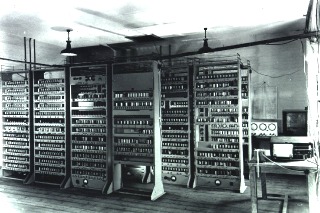 EDSAC I, June 1948
EDSAC I, June 1948Copyright Computer Laboratory, University of Cambridge. Reproduced by permission.
Early computers weren't exactly meant to play games. They were used by the military to crack enemy codes or calculate trajectories of artillery missiles.
The first computer aimed at solving general problems, whatever those might be, was EDSAC I, or Electronic delay storage automatic calculator. It took two years to build and ran its first programs on May 6, 1949 at the University of Cambridge Mathematical Laboratory. These were a table of squares and a list of prime numbers.
The computer was able to address 1,024 18-bit words. The topmost bit wasn't used, though, because of timing problems. Hence, the storage was limited to 17K, but only half of it was installed initially.
The first game for EDSAC was developed by Alexander "Sandy" Douglas in 1952. He was working on his thesis about human-computer interactions and created a sample program to play tic-tac-toe against a human rival. The program was called OXO, or Noughts and Crosses.
The game field was presented on one of computer's three CRT displays. The nine cells were given numbers from 1 to 9. The players entered their moves – indicating which cell they intended to fill next – over a telephone dial. The move appeared on the display, then it was computer's turn.
Understandably, the game wasn't available to general public and could only be played by special permission. EDSAC remained functional until July 1958 when it was replaced by its successor EDSAC 2.
The EDSAC simulator for Windows is available to download—refer to the links section.
 Draughts played on Ferranti Mark 1Around the same time, Christopher Strachey created a computer program capable of playing draughts, aka checkers.
Draughts played on Ferranti Mark 1Around the same time, Christopher Strachey created a computer program capable of playing draughts, aka checkers.
The program ran initially on the Pilot ACE at the National Physical Laboratory in Teddington, London claiming the entire memory available.
In 1952, Strachey ported the game for use on Ferranti Mark 1, the world's first commercially available general-purpose computer, which had a much bigger memory and a CRT display.
In the beginning was the word
The first adventure computer game was Colossal Cave Adventure developed by Will Crowther in 1976 to run on a PDP-10 mainframe. The player entered text commands which were interpreted by the computer to control the game flow and provide the feedback.
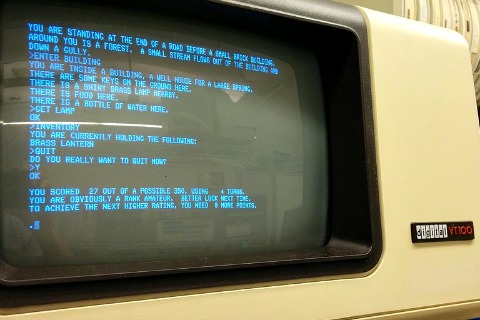 Colossal Cave Adventure running on PDP-11
Colossal Cave Adventure running on PDP-11The aim of the game was to explore its eponymous cave, find treasures hidden within, and escape alive. The following year, the game was expanded by Don Woods to introduce a scoring system, additional treasures, and new game elements. The complete game included 140 map locations, 53 objects, and "understood" 293 words.
The game proved popular and was ported to IBM mainframes, Commodore 64, Apple II Plus, and TRS-80. Microsoft included the game with the initial version of MS-DOS, making it the first game title available for the new IBM PC.
“Never say 'no' to adventures. Always say 'yes', otherwise you'll lead a very dull life.”
Ian Fleming
A long time ago...
In 1979, Ken Williams, then 25 and a programmer at IBM, bought an Apple II with the intention to write a Fortran compiler for it. To this purpose, he and his wife Roberta founded a software company, On-Line Systems.
Both had played Colossal Cave Adventure before, and Roberta was eager to create something similar for Apple II. Well, quite. The small Apple offered a graphical display and ... an opportunity.
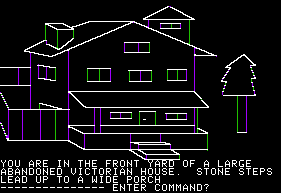 Initial screen of Mystery House
Initial screen of Mystery HouseRoberta designed, wrote and illustrated an adventure game loosely based on Agatha Christie's And Then There Were None. The program was developed by Ken around his wife's drawings (some 70 in total).
The player entered a lonely house where s/he met seven other characters and found a note about a treasure hidden inside.
Sounds familiar?
With the door locked behind, the protagonist had no choice but start exploring the surroundings. Unsurprisingly, these were full of traps, which better were avoided, and puzzles, which needed to be solved to survive. Soon enough, the player learned from obvious hints, e.g., dead bodies strewn around, that a killer was on the loose in the house.
The interaction involved typing in commands, which usually consisted of a verb and an object or another word ("read note", "look down", "light match", etc.) To move around, directions or their abbreviations were used ("north", or "n" for the top of the screen).
Mystery House was released in 1980 to become the first graphical adventure game and the first title in On-Line Systems' Hi-Res Adventures series.
The package consisted of a 5¼" floppy disk and a photocopied paper description in a Ziploc bag. The first release sold at $24.95 in local software shops in Los Angeles County and did it more than 10,000 times. Overall, the game went on to sell 80,000 copies worldwide, making it a best seller at the time.
Hi-Res Adventures continued with six more titles. In 1982, On-Line Systems became Sierra On-Line
...in a galaxy far, far away...
In late 1982, IBM contacted Sierra to create a game for their forthcoming new PCjr. The development took Roberta Williams and six programmers 18 months to complete. The resulting game, King's Quest, was released in May 1984.
The game engine created in the process was later named Adventure Game Interpreter (AGI). Its use effectively reduced new game development to scripting and drawing – the mechanics behind the scenes remained the same. This hugely accelerated the rate at which new games could be created and ported to different platforms. Between 1984 and 1990, Sierra published 77 versions of 14 game titles using AGI.
From now on, new adventures sprang up like mushrooms.
The majority of following images are real game screenshots and copyright their respective owners, usually game publishers. The images are used for information and illustration purposes only.
For availability of the games mentioned here, refer to the next chapter.
Space Quest: The Sarien Encounter
When?
First release October 1986, reissued several times, included in several game collections.
Who's responsible?
Designed by Mark Crowe and Scott Murphy, aka Two Guys from Andromeda. Developed and published by Sierra On-Line. Powered by AGI game engine.
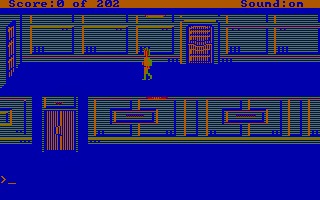 Initial CGA release, initial screen
Initial CGA release, initial screenWho are you?
You. The game asks for your name in the beginning. If you don't provide any, you are called Roger Wilco.
You are a member of the cleaning crew aboard the spaceship Arcada. The ship carries an experimental device called Star Generator, designed to transform a planet into a sun.
What's the story?
After a nap in a broom closet while on duty, you wake up to find the spaceship under attack, your fellow crew killed, and the Star Generator stolen.
What's the point?
Stay alive and save the world.
What can you gain?
202 score points, and a Golden Mop in the end.
Where would you go?
SS Arcada, planet Kerona, town of Ulence Flats, alien spaceship Deltaur.
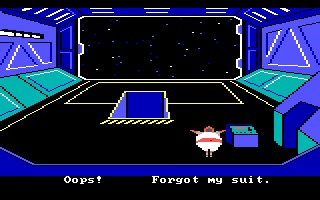 Vacuum is bad for your health
Vacuum is bad for your healthCan you die?
You bet. Save often.
How did it look?
The original release had a resolution of 320x200 with 16 colours. The sound on PC came out of the internal speaker.
How did it play?
With keyboard and (optional) joystick. Text commands to perform actions and arrow keys (or joystick) to move around.
Anything else?
Hugely enjoyable. Spawned a franchise with five sequels.
Can you still play it?
Yes! — ScummVM, GOG.com
Space Quest II: Vohaul's Revenge
When?
First release November 1987.
Who's responsible?
The usual suspects. Designed by Mark Crowe and Scott Murphy. Developed and published by Sierra On-Line. Powered by AGI game engine.
Who are you?
Roger Wilco, forgotten hero and holder of the Golden Mop, Head (and only) Janitor on Xenon Orbital Station 4.
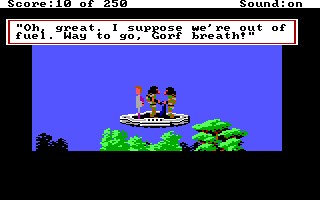 You are in for an adventure
You are in for an adventureWhat's the story?
After having let your broom fly into space while performing your daily duties outside the station, you return to the latter only to be abducted by Sludge Vohaul, the villain from the previous game, and sent to the mines of Labion for the rest of your life. Luckily, your pod crashes into the jungle on the way.
What's the point?
Stay alive and save the world.
What can you gain?
250 score points, and your own revenge in the end.
Where would you go?
Xenon Orbital Station 4, planet Labion, Vohaul's asteroid.
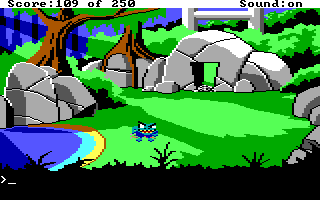 A monster you summoned
A monster you summonedCan you die?
Yes, in many unpredictable and unpleasant ways. Save often.
How did it look?
Original version is technically the same as its predecessor, i.e., 320x200 with 16 colours. Later EGA ports have more detail in backgrounds and shadows, compared to Chapter I.
How did it play?
Again, the same as Episode I, with keyboard and optional joystick.
Anything else?
Even better than the first part. The game was listed number four of Sierra's Top 5 Bestsellers, and must have sold over 100,000 copies.
The game ends just like Alien, the film, did, and its sequel, Space Quest III: The Pirates of Pestulon, starts just like Aliens.
Can you still play it?
Yes! — ScummVM, GOG.com
Myst
When?
Original release in September 1993. Masterpiece Edition with 24-bit colour in May 2000. realMyst: 3D Edition in November 2000 (Windows) / January 2002 (Mac).
Who's responsible?
Designed by Rand and Robyn Miller. Developed by Cyan. Published and distributed by Brøderbund. Powered by HyperCard (Mac OS) and Mohawk (Windows) game engines.
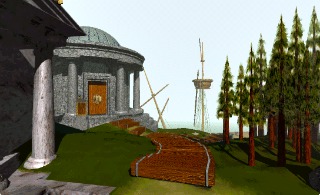 You are on an island, alone. Explore.
You are on an island, alone. Explore.Who are you?
You, someone, a stranger. Doesn't matter.
What's the story?
You find a book and are transported by it to a mysterious island.
What's the point?
Explore. Find and free the creator of books and Ages.
What can you gain?
Nothing. The successful ending leaves you exactly where you started. You are free to explore further, confined to the realm of the game.
 Stoneship Age
Stoneship AgeWhere would you go?
The island of Myst and four worlds, called Ages, created by Atrus and destroyed by his sons.
"Worlds called Ages"—speak of spacetime.
Can you die?
No. You are pretty much alone during the whole game. Even if you make a bad choice in the very end – which would be quite surprising, but you can choose wrong – you just stay confined to a tighter space, that's all.
How did it look?
Gorgeous static screens and occasional short movie sequences. The original game resolution is 544x332 with 256 colours. It uses dithering to achieve an almost true-colour look and feel.
 Selenitic Age
Selenitic AgeHow did it play?
From a CD, with mouse. This is a true point-and-click game from the first person point of view. You have to solve puzzles which don't feel like puzzles at all. The game goes without an inventory. You can carry only one item at a time, and this is mostly a single book page.
Anything else?
The title sold over 6 million copies. It stayed the most successful computer game up to 2002. Its four direct sequels – Riven, Exile, Revelation, and End of Ages – were all remarkable in their own right.
Can you still play it?
Yes! — ScummVM (Windows version only), GOG.com
The Dig
When?
November 1995.
Who's responsible?
Conceived by Steven Spielberg as a possible feature film, but deemed too expensive to realise. Developed and published by LucasArts. Powered by SCUMM game engine.
Who are you?
Commander Boston Low.
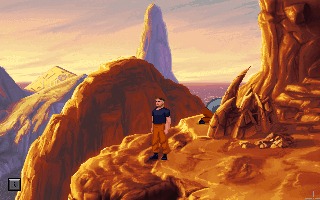 Up in the mountains
Up in the mountainsWhat's the story?
When a radio telescope detects a big asteroid on a collision course with Earth, a space mission is sent to plant explosives on the surface of the intruder and force it into a stable orbit. You lead this mission. While at it, you and two other crew members, an archaeologist and a journalist, discover that the asteroid is actually a spacecraft, and set it in motion. The pod brings you to an alien planet and releases you on an island. You find traces of a highly-developed alien civilization, but no-one around.
What's the point?
Explore, save the world, and return to Earth, in this order.
What can you gain?
Going home, the beginning of a wonderful friendship, and possibly more.
Where would you go?
Outer space, an alien world, and beyond.
Can you die?
No—it's a LucasArts game.
How did it look?
Ugly. I mean it. 640x400 with 256 colours.
How did it play?
With mouse. This is a classic point-and-click adventure, with an inventory and dialog options to choose from.
Anything else?
The game was an unusual title for LucasArts, as it dealt with real human characters, unlike, say, the Monkey Island series and their other cartoonish output.
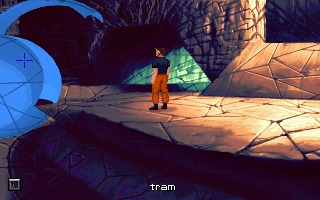 Public transportation is provided
Public transportation is providedThe gameplay is similar to Myst, in that you have to figure out and restore the mechanics of a strange world. The puzzles, while complicated, are all logical, and you don't have to search badly lit spaces for hidden switches.
The music score is very impressive, as are animated tram ride sequences.
If you ever play Riven, the sequel to Myst, you will get to remember them.
All in all, I enjoyed playing The Dig a whole lot. Repairing a defunct civilization can be utterly satisfactory!
Can you still play it?
Yes! — ScummVM, GOG.com
The Last Express
When?
March 1997.
Who's responsible?
Designed by Jordan Mechner, of Prince of Persia fame. Developed by Smoking Car Productions, a company created to make the game. Published by Brøderbund. Powered by a proprietary engine.
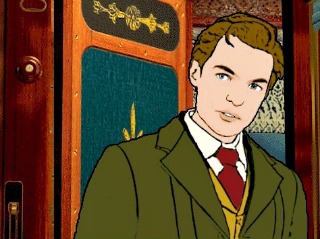 Meet Robert Cath
Meet Robert CathWho are you?
Robert Cath, an American doctor in Europe on the brink of the World War.
What's the story?
While staying in Paris, you receive a telegram from your friend Tyler Whitney asking you to join him aboard the Orient Express departing for Constantinople on July 24, 1914. Since you are wanted by the police, you get on the train after it has left the station. You find Tyler on the floor in your compartment, obviously murdered.
What's the point?
Dispose of the body, discover a conspiracy, solve the murder, stay alive, get to Constantinople, all in real time.
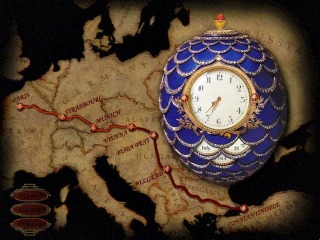 Main menu, itinerary, and ticking clock
Main menu, itinerary, and ticking clockWhat can you gain?
A short-lived love, and a dog.
This is the saddest game you'll ever play. Even if you succeed in reaching your destination, you'll find yourself alone, by a burning train, in a world gone mad.
Where would you go?
All across Europe along the route of the Orient Express.
Can you die?
For sure, and you will. When you do, you will return to the last point in the game where you can still avoid your looming fate. You don't have to think of saving your progress – it happens automatically.
How did it look?
Stylish, at 640x480 with 24-bit colour. The game uses real actors filmed in front of the blue screen. The film stock was desaturated and run through a program which transformed it into drawings. These drawings were then coloured by hand. The process is called rotoscoping. The resulting look and feel is quite special and unique.
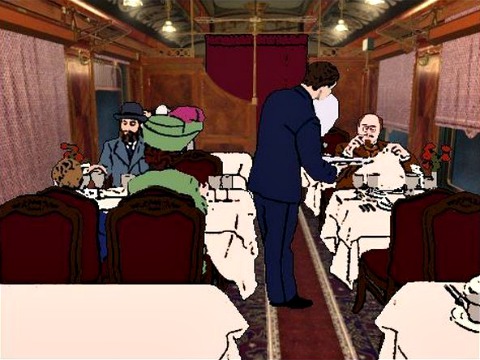 Dining car in The Last Express
Dining car in The Last Express …and in the Orient Express, before 1900
…and in the Orient Express, before 1900How did it play?
With mouse. This is a a very realistic point-and-click adventure. Most of the game is in the first person point of view, while cut and fight scenes run from the side. There is an inventory, but you can't walk around with bulky objects and pretend that nobody would notice.
The events take place in real time and independent from each other. All characters have lives and agendas of their own, meaning, if Cath is doing something in one place, he is inevitably missing on whatever is happening elsewhere. The chronology is scripted and makes the game a truly interactive experience.
All dialogs are scripted, too, so if you choose to talk, do it with care, as you can't control what you are saying.
Voice actors are native speakers, which is a great relief for a change. The only strange thing about this is when a German merchant and an Austrian violinist talk in English to each other. Cath understands several languages, and when he does, the foreign dialogs he overhears are subtitled.
Anything else?
The game took five years to develop, received very positive reviews, but was a commercial disappointment. The complete Brøderbund marketing team quit weeks before the release date, and the company did little to promote the game. Finally, the acquirement of Brøderbund by The Learning Company was no help, either. The game ended up a million copies short of breaking even.
Somehow, this reminds of its overall mood and the fate of its characters.
Can you still play it?
Yes! — GOG.com
Grim Fandango
When?
Original release in October 1998.
Who's responsible?
Designed by Tim Schafer. Developed and published by LucasArts. Powered by GrimE engine.
Who are you?
Manuel "Manny" Calavera, a travel agent at the Department of Death in the city of El Marrow, the Land of the Dead.
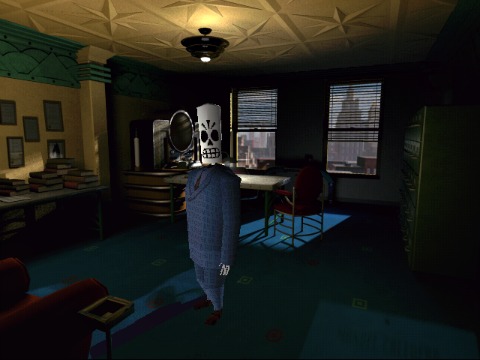 That's you, in your office
That's you, in your officeWhat's the story?
The Land of the Dead is the place where recently departed souls start their journey towards the Land of Eternal Rest. The lives they led make them qualify for travel packages with different comfort levels, from a four-year trek to a ride aboard the luxury Number Nine train. Manny, who is doing his job to work off a debt to "the powers that be", notices that his clients don't qualify for much more than a walking stick, gets frustrated, and steals a client, Mercedes "Meche" Colomar, from his colleague, Domino Hurley. Though Manny believes that she should be good enough for a spot on the Double N, his computer still sends her on a four-year trip of hardship. Driven by a suspicion, he investigates to discover a conspiracy involving denying luxury packages to their legitimate owners in order to sell them at exorbitant prices to those who would pay. So begins his own journey.
What's the point?
Punish the bad guys, find your love, and eternal rest.
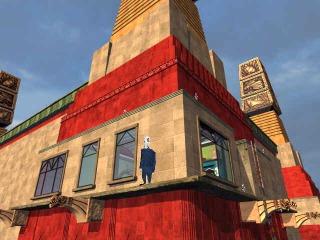 Manny's up to something
Manny's up to somethingWhat can you gain?
The same as above: Your revenge, your love, your piece.
Where would you go?
The city of El Marrow, the Petrified Forest, the port of Rubacava, the sea floor, the Edge of the World, the Ninth Underworld.
Can you die?
No—it's another LucasArts game!
If you thought you couldn't die because you are already dead, just play and see.
How did it look?
Wow. Technically, 640x480 with thousands of colours (16-bit). The game mixes pre-rendered static backgrounds with 3D characters and objects. Cut scenes are phenomenal.
How did it play?
Keyboard interface, with LucasArts-usual selection of what to say. Moving Manny around can be tricky. Puzzles are rather difficult, especially in the beginning, when there is little objective to do something.
The game's scale is epic, and its size is, simply put, huge. Cut scenes alone run for over an hour and do look very cinema-like, in the tradition of the best film noir titles. The music score and the voice acting are second to none.
Everybody smokes! It's a film noir, after all.
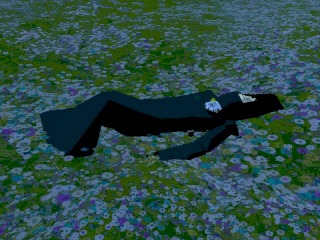 Oh no, this can't be, can it?
Oh no, this can't be, can it?Anything else?
The game was late to get ready, and even then several puzzles had to be
dropped due to the lack of time, including the original design for the
final coup.
It won several Adventure Game of the Year awards, and entered a few Best-of lists, but did just OK commercially.
Can you still play it?
Yes! — ResidualVM, GOG.com
“He remembers those vanished years. As though looking through a dusty window pane, the past is something he could see, but not touch. And everything he sees is blurred and indistinct.”
Caption from In the Mood for Love
Play it again, Sam
If you want to (re)play the games of yore, these are your best options.
If you still own the original games, check ScummVM. The Open Source project makes old game engines available, and their games playable on different modern platforms. You need to install just one application on your device to be able to play (as of June 2020) over 250 titles.
Every supported game is provided with the list of original files required to run it in ScummVM. Copy the files into a folder on your hard drive and select the folder when adding the game to the virtual machine. Enjoy!
A spin-off project, ResidualVM, brings back two more games, Grim Fandango and Myst III: Exile.
If you don't have the original disks at hand, head over to GOG.com and buy the game, then download it.
GOG stands for Good Old Games. It is a European company with offices in Warsaw, Poland and Nicosia, Cyprus. Though it's not the only one around, there are several good reasons to buy from them:
- Near 1,900 available games, with new titles added every week.
- All games are DRM-free: You buy something, you own it. You can install your copy on any of your devices – it's part of the deal.
- You don't need to install anything else: Your game will run by itself.
- You don't require an Internet connection to play: After your download is complete, feel free to pull the plug.
- The games are very reasonably priced: Regular prices start at as low as $5.99, and there are frequent sales, when you can save up to 80%.
- The prices are fair: A title costs the same anywhere in the world, and in each of 12 supported currencies.
Give them a try! They offer games of any genre, and movies as well.
Useless knowledge: The king of trains
 Orient Express on a coloured postcard, c. 1900
Orient Express on a coloured postcard, c. 1900The first direct train service between Paris and Constantinople left the French capital on August 12, 1888. In charge of it was Compagnie Internationale des Wagons-Lits (CIWL), International Company of Sleeping Cars, founded five years earlier.
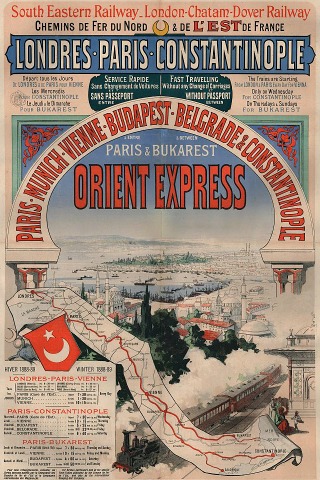 CIWL poster, 1888
CIWL poster, 1888In its first season, the train made one weekly run, departing from Paris on Wednesday evening and arriving at its destination three days later. On other days, the service finished in Vienna, or continued via Budapest to Bucharest. Feeder trains were available from London, Brussels, and Berlin.
In the 1914 schedule, the travel time between Paris and Constantinople was set at 59 hours, and direct trains departed two times a week. This service was to remain the fastest ever on the route.
The train was exclusively first-class, and only contained sleeping and dining cars along with baggage wagons. The end-to-end, one-way trip cost enough to make the operation profitable with only 14 passengers on board. 1,750 euros in modern funds amounted to a quarter of an average annual income in France.
 Sleeping beauty, built for CIWL in Germany, 1908
Sleeping beauty, built for CIWL in Germany, 1908Until 1922, all CIWL sleeping cars were clad with teak and equipped with central heating, hot running water, and gas lighting. Compartments featured tapestry, comfortable mattresses, and bathrobes. Silk linen, marble mountings, crystal glasses and silver cutlery were at passengers' disposal.
 Inside the compartment, 1929
Inside the compartment, 1929After the World War, the service commenced on April 11, 1919. The route changed to avoid Germany and Austria, leading from Paris via Annecy, Lausanne, Brig, and the Simplon tunnel to Milan, Verona, Venice, Triest, Zagreb, and Belgrade. From there, it rejoined its old route on to Sofia and Constantinople. This train, called Simplon Orient Express, is what many now consider the real thing.
This is the train aboard which the famous murder scripted by Agatha Christie happened. The novel was inspired by a real incident in 1929, when the train was snowed in for five days near Çerkezköy in Turkey on its return run from Constantinople to Calais. The passengers resorted to hunting, and had to eat wolves to persevere.
Though several crimes were committed on board, including robbery, kidnapping, and most definitely smuggle, a real murder wasn't reported.
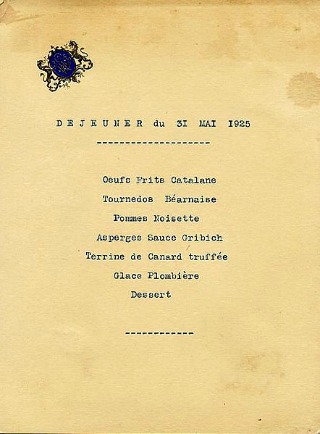 Lunch menu for May 31, 1925
Lunch menu for May 31, 1925Image by WLDiffusion, via Wikimedia Commons
The second World War interrupted the operation one more time. After it, the train was never the same again. Increasingly, it became a usual international service, with several classes and day coaches. The changing political climate made travelling across borders in Europe a real challenge. If someone still remembered riding "from London to Istanbul without a passport", this would be unthinkable now.
The last, solitary through coach left Paris for Istanbul in the late evening on May 19, 1977. The departure was scheduled at 23:56, but the train was several minutes late, so it probably was the 20th already.
The real last express, EuroNight train number 469 Orient Express, departed from Strasbourg at 20:37 on December 12, 2009, and arrived in Vienna, its final destination, at 6:40 the next morning.
After 126 years of service, the Orient Express became history.
“It’s no use going back to yesterday, because I was a different person then.”
Lewis Carrol, Alice in Wonderland
‘What day is it?’, asked Winnie the Pooh.
‘It's today’, squeaked Piglet.
‘My favourite day’, said Pooh.
A. A. Milne, Winnie-the-Pooh
Tags: #inplainlight #radiooooo #retrogaming #orientexpress
Recommended links
- Radiooooo.com – The Musical Time Machine
- Listen to the tunes from the past in the way it used to be.
- The EDSAC Simulator
- Ever wanted to feel like the first programmer on Earth? Here's your chance: download the simulator and put it to some use. A description is available, as are several sample programs. Should run on every Windows version starting with Windows 95.
- Colossal Cave Adventure online
- Play the PC version of the first ever Adventure.
- Mystery House online
- Play Mystery House, the first graphical adventure game, in your browser. (This is buggy, but you get an idea.) By the way, you can also download the game from ScummVM's site and play it "for real".
- ScummVM and ResidualVM
- Run your favourite adventure games on a modern platform of your choice.
- GOG.com (formerly Good Old Games)
- Download DRM-free games for Windows, OSX and Linux at very reasonable prices. Over 4,000 available and growing.
- Paper Trails to the East: Posters and brochures for the Orient Express
- A fascinating look over a hundred years advertisement for the most famous train in the world, and many more materials related to travel by rail elsewhere.
Previous issue
- 03.17 – The marketing issue
- This issue is about creating your brand and marketing your work, told by those who've been there and done exactly that.
Following issue
- 05.17 – The Norway issue
- Follow me along the coast of the happiest country in the world, all the way around the North Cape to the Russian border—and back.
Unattributed images on this page are sourced from public domain via Pixabay and Wikimedia Commons.
Tell me what you think!
Is it useful 👍? Awful 👎? Leave a message! Your comments help make this site better (and give me a kick—one way or another).
Popular articles
-
A kind of magic
If a digital picture has to be seen in the real world, printed on a real medium and displayed in a real showcase, its transition from RAW to real is better done in an old school image editor. Enter A…
-
A duck for a dog
If you got your own place on the Internet, helping your visitors find what they are looking for is a great way to engage them and keep them staying a bit longer. A custom site search can achieve just …
-
"Might as well have the best"
Aiming for better images? Think better lenses! This is your most important piece of gear, so you better get it sorted out. — Need some advice?
 Become a patron for
Become a patron for